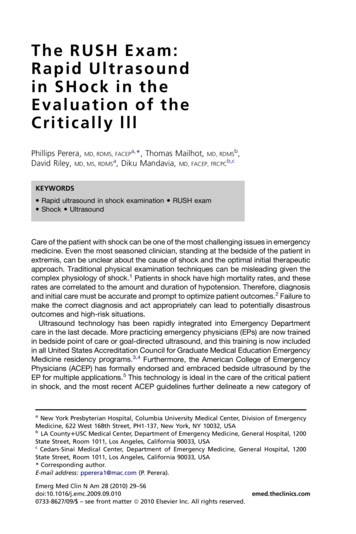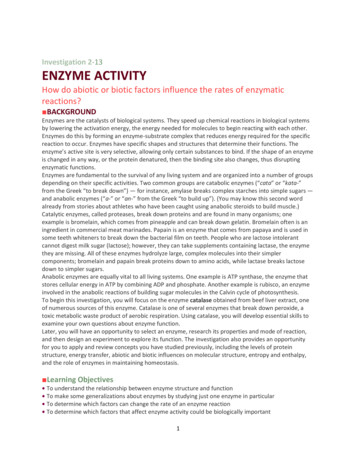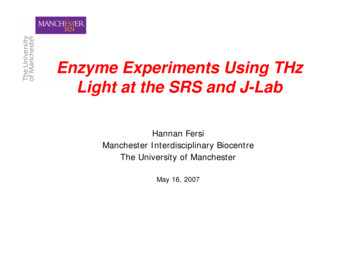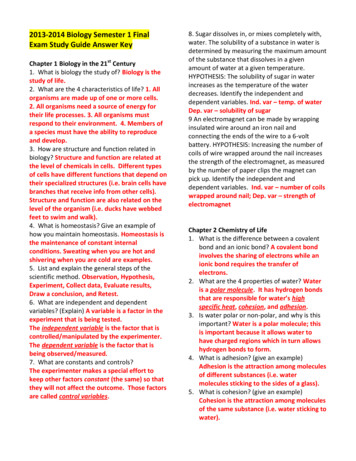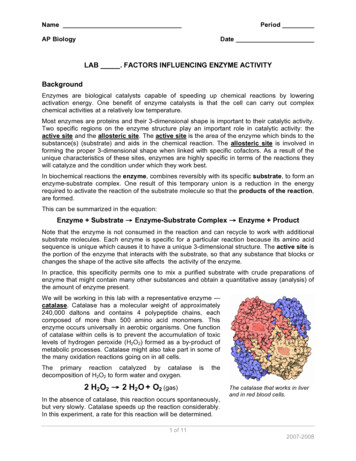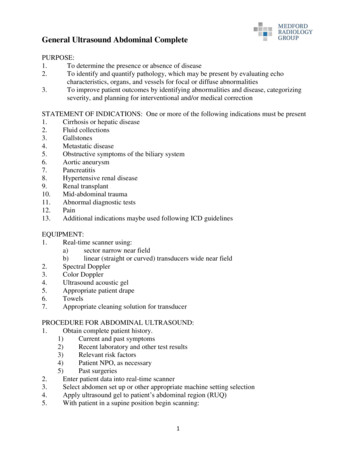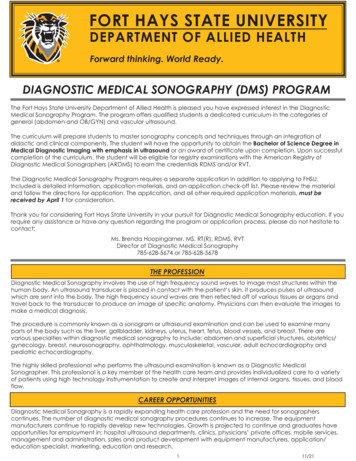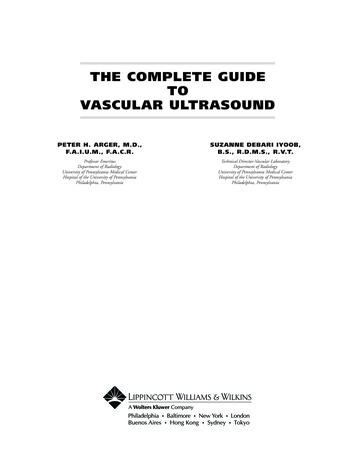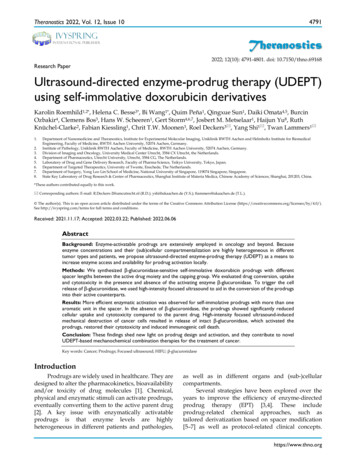
Transcription
Theranostics 2022, Vol. 12, Issue 104791IvyspringTheranosticsInternational Publisher2022; 12(10): 4791-4801. doi: 10.7150/thno.69168Research PaperUltrasound-directed enzyme-prodrug therapy (UDEPT)using self-immolative doxorubicin derivativesKarolin Roemhild1,2*, Helena C. Besse3*, Bi Wang1*, Quim Peña1, Qingxue Sun1, Daiki Omata4,5, BurcinOzbakir4, Clemens Bos3, Hans W. Scheeren1, Gert Storm4,6,7, Josbert M. Metselaar1, Haijun Yu8, RuthKnüchel-Clarke2, Fabian Kiessling1, Chrit T.W. Moonen3, Roel Deckers3 , Yang Shi1 , Twan Lammers1 1.2.3.4.5.6.7.8.Department of Nanomedicine and Theranostics, Institute for Experimental Molecular Imaging, Uniklinik RWTH Aachen and Helmholtz Institute for BiomedicalEngineering, Faculty of Medicine, RWTH Aachen University, 52074 Aachen, Germany.Institute of Pathology, Uniklinik RWTH Aachen, Faculty of Medicine, RWTH Aachen University, 52074 Aachen, Germany.Division of Imaging and Oncology, University Medical Center Utrecht, 3584 CX Utrecht, the Netherlands.Department of Pharmaceutics, Utrecht University, Utrecht, 3584 CG, The Netherlands.Laboratory of Drug and Gene Delivery Research, Faculty of Pharma-Science, Teikyo University, Tokyo, Japan.Department of Targeted Therapeutics, University of Twente, Enschede, The Netherlands.Department of Surgery, Yong Loo Lin School of Medicine, National University of Singapore, 119074 Singapore, Singapore.State Key Laboratory of Drug Research & Center of Pharmaceutics, Shanghai Institute of Materia Medica, Chinese Academy of Sciences, Shanghai, 201203, China.*These authors contributed equally to this work. Corresponding authors: E-mail: R.Deckers-2@umcutrecht.nl (R.D.); yshi@ukaachen.de (Y.S.); tlammers@ukaachen.de (T.L.). The author(s). This is an open access article distributed under the terms of the Creative Commons Attribution License (https://creativecommons.org/licenses/by/4.0/).See http://ivyspring.com/terms for full terms and conditions.Received: 2021.11.17; Accepted: 2022.03.22; Published: 2022.06.06AbstractBackground: Enzyme-activatable prodrugs are extensively employed in oncology and beyond. Becauseenzyme concentrations and their (sub)cellular compartmentalization are highly heterogeneous in differenttumor types and patients, we propose ultrasound-directed enzyme-prodrug therapy (UDEPT) as a means toincrease enzyme access and availability for prodrug activation locally.Methods: We synthesized β-glucuronidase-sensitive self-immolative doxorubicin prodrugs with differentspacer lengths between the active drug moiety and the capping group. We evaluated drug conversion, uptakeand cytotoxicity in the presence and absence of the activating enzyme β-glucuronidase. To trigger the cellrelease of β-glucuronidase, we used high-intensity focused ultrasound to aid in the conversion of the prodrugsinto their active counterparts.Results: More efficient enzymatic activation was observed for self-immolative prodrugs with more than onearomatic unit in the spacer. In the absence of β-glucuronidase, the prodrugs showed significantly reducedcellular uptake and cytotoxicity compared to the parent drug. High-intensity focused ultrasound-inducedmechanical destruction of cancer cells resulted in release of intact β-glucuronidase, which activated theprodrugs, restored their cytotoxicity and induced immunogenic cell death.Conclusion: These findings shed new light on prodrug design and activation, and they contribute to novelUDEPT-based mechanochemical combination therapies for the treatment of cancer.Key words: Cancer; Prodrugs; Focused ultrasound; HIFU; β-glucuronidaseIntroductionProdrugs are widely used in healthcare. They aredesigned to alter the pharmacokinetics, bioavailabilityand/or toxicity of drug molecules [1]. Chemical,physical and enzymatic stimuli can activate prodrugs,eventually converting them to the active parent drug[2]. A key issue with enzymatically activatableprodrugs is that enzyme levels are highlyheterogeneous in different patients and pathologies,as well as in different organs and (sub-)cellularcompartments.Several strategies have been explored over theyears to improve the efficiency of enzyme-directedprodrug therapy (EPT) [3,4]. These includeprodrug-related chemical approaches, such astailored derivatization based on spacer modification[5–7] as well as protocol-related clinical concepts.https://www.thno.org
Theranostics 2022, Vol. 12, Issue 10Examples of the latter are gene- (GDEPT) [8,9], virus(VDEPT) [10–12], antibody- (ADEPT) [13–15] andpolymer-directed enzyme-prodrug therapy (PDEPT)[16]. While conceptually elegant, none of theseapproaches has resulted in translational success. Thisis mostly because they all require full clinicalco-development of an accompanying second drug,just serving to activate the prodrug, which is not verycost-effective, and also challenging from a regulatorypoint of view. Furthermore, considering the differentphysicochemical and pharmacokinetic properties ofsmall molecule prodrugs versus the enzymedelivering nanoparticles, antibodies, and polymers, itis difficult to ensure a matching biodistribution, i.e., agood overlap in temporal and spatial co-localizationfor the prodrugs and the accompanying activatingagents.To bypass the above limitations, we here propose ultrasound-directed enzyme-prodrug therapy(UDEPT). Focused ultrasound (FUS) is nowadaysapplied non-invasively, in a very well-controllablemanner. Its use has rapidly expanded over the years,4792for multiple different diseases. Particularly highintensity focused ultrasound (HIFU) has been gainingmuch attention, serving as a non-invasive ablationalternative for surgical interventions and percutaneous radiofrequency ablation [17]. In cancer, HIFUhas been employed to induce mechanical or thermaldamage to malignant tissue, thereby promoting thenecrosis of tumor cells [18]. From a prodrug activationpoint of view, we hypothesize that HIFU viamechanical destruction, a process also known ashistotripsy [19,20], is an ideal modality to locallytrigger the release of intact enzymes from cancer cellsin a manner that is temporally and spatially tailorableand tightly controllable, without compromisingenzyme activity.As depicted schematically in Figure 1, UDEPT isparticularly useful for cleaning up the tumor marginborder zones. These are located between theFUS-ablated dead tumor cores and the neighboringnon-affected rims, which typically remain viable andoften contain surviving cancer cells responsible forlocal disease relapse (Figure 1, panel 1).Figure 1. Schematic illustration of FUS tumor ablation potentiated by UDEPT with β-GUS-sensitive self-immolative DOX prodrugs. FUS mechanicallydestroys cancer cells and thereby increases the extracellular levels of β-GUS for DOX prodrug activation. (A) FUS alone induces cancer cell death in the tumor core and leavesthe outer tumor margin and the viable rim intact, often resulting in disease relapse. (B) The combination of FUS with standard chemotherapy (CTx) leads to strong tumorreduction but comes with a high level of off-target toxicity in healthy tissues. (C) Combining FUS with UDEPT results in the destruction of the tumor core, release of β-GUS,activating prodrugs in the tumor rim, and killing cancer cells in the outer tumor margin. Off-target toxicity in healthy tissues is attenuated due to the lack of enzyme activationthere. Figure generated using BioRender.https://www.thno.org
Theranostics 2022, Vol. 12, Issue 10In a UDEPT setup, the tumor core ismechanically destroyed by FUS, killing the tumorcells and releasing intracellular enzymes. Theseenzymes then diffuse locally and display theiractivities in the outer tumor core and in theneighboring viable margin zones, convertingprodrugs into active parent drugs and killing theremaining cancer cells there. At the same time,healthy tissue surrounding the tumor and other areasin the body remain relatively unaffected (Figure 1,panel 3). This as opposed to situations in which FUSinduced tumor ablation is combined with standardchemotherapy, and in which significant healthy tissuetoxicity can be expected (Figure 1, panel 2).As a first step towards realizing UDEPT as ameans to improve FUS ablation therapy, we set out todevelop prodrugs that are efficiently activated byenzymes released upon ultrasound-induced mechanical cell death. We focused on β-glucuronidase(β-GUS), because β-GUS is only present within cellsunder physiological conditions, specifically withinlysosomes. In pathological situations, e.g. in tumorswith large necrotic areas, β-GUS can also be foundextracellularly, although its levels are highly variablein different cancer types and tumor stages [21,22].Even though in vivo studies have shown successfullythe use of EPT [3,4], by promoting necrotic cell death,as induced very potently via FUS-mediatedmechanical cell destruction, the availability of β-GUSin the tumor extracellular space and in the tumorborder margin zones is strongly increased, where itcan then assist in activating prodrugs containingβ-D-glucuronide as a capping group.Based on this reasoning, we synthesized a seriesof self-immolative β-D-glucuronide-capped doxorubicin (DOX) prodrugs, taking pioneering previousefforts in this regard into account [23–25]. Wedesigned prodrugs to contain different spacer lengthsbetween the anthracycline drug moiety and y studied the impact of prodrug designon enzyme activation kinetics. We chose to developprodrugs based on self-immolative linkers becausethese have several unique features over other prodrugdesigns, including tunable activation kinetics [26].Our results show that spacer length affects prodrugactivation kinetics, cellular uptake and cytotoxicity.They also demonstrate that β-GUS released fromHIFU-destroyed cancer cells remains active, and thatthe β-GUS-containing cell lysate obtained uponmechanical ablation activates prodrugs in a spacerlength-dependent manner. Together, our workprovides promising initial proof-of-concept for theuse of UDEPT-based mechanochemical combinationtherapies for solid tumor treatment.4793Material and MethodsMaterialsD-( )-glucuronic acid γ-lactone, pyridine,methyl-(p-hydroxymethyl) benzoate, triethylamine(TEA), acetic acid, dichloromethane (DCM),acetonitrile (ACN), methanol (MeOH), heptane, ethylacetate, toluene, tetrahydrofuran (THF), N,N-dimethylformamide (DMF) were ordered from CarlRoth. Tert-butyldimethylsilyl chloride (TBDMSCl),diphenyl phosphoryl azide (DPPA), lithiummethoxide solution (LiOMe), 4-nitrophenyl chloroformate (Cl-COOPhNO2) were ordered from Sigma.Doxorubicin hydrochloride salt (DOX·HCl) wasordered from Biomol.SynthesisThe synthetic route of DOX AU1-3 is depicted inScheme 1. Detailed experimental procedure isdescribed in the supplementary information.Characterization by 1H-NMR, ESI-MS, andHPLC1H-NMR: 1H-NMRspectra of the synthesizedcompounds were recorded using a Bruker 600 FTNMR spectrometer in CD3OD, or CDCl3 or DMSO-d6as indicated in the methods. Chemical shifts werereported as δ values (ppm) with tetramethylsilane(TMS) as the internal reference. Multiplicities wereshown as s (singlet), d (doublet), t (triplet), m(multiplet); coupling constants (J) were displayed inHertz (Hz), rounded to the nearest 0.1 Hz. ESI-MS:Full spectrometry was recorded with ThermoFisherLTQ-Orbitrap XL, positive ion mode, m/z (rel.intensity %). Reversed-phase analytical HPLC: HPLCanalyses were measured in a C18 column, with agradient elution method (40% ACN / 60% H2O 0.1%TFA to 95% ACN / 5% H2O 0.1% TFA in 11minutes). The flow rate was 1 mL/min and thedetection wavelength, 486 nm.Activation of DOX-AU1-3 by β-GUSDOX-AU1-3 were dissolved in DMSO to prepare1 mM stock solutions, which were diluted in PBS (pH7.4 or 6.5) containing β-GUS (activity 1,000units/mg, ordered from Sigma) to yield mixtures of50 μM DOX-AU1-3 and 50 μg/mL β-GUS in thesolutions. Afterwards, the mixtures were kept at 37 C, and 200 μL of samples were taken out from thesolutions at scheduled time points. The samples wereanalyzed by HPLC to detect the concentrations ofDOX-AU1-3 and DOX. All the experiments wereperformed in triplicates. HPLC conditions: C18column; gradient elution method (40% ACN / 60%H2O 0.1% TFA to 95% ACN / 5% H2O 0.1% TFAhttps://www.thno.org
Theranostics 2022, Vol. 12, Issue 10in 11 minutes). The flow rate was 1 mL/min, and thedetection wavelength of 486 nm.Cell cultureMouse mamma carcinoma (4T1, ATCC CRL2539) and mouse embryo fibroblast (NIH/3T3, ATCCCRL-1658) were obtained from ATCC (Rockville, MD,USA) and cultured in RPMI 1640 and Dulbecco’sModified Eagle’s Medium (DMEM), respectively(Sigma). The medium was supplemented with 10%Fetal Bovine Serum (Sigma F7524) and 1%penicillin-streptomycin–amphotericin B (Sigma).Cells were cultured at 37 C in 5% CO2 in an airhumidified incubator and regularly tested negativefor mycoplasma contamination.Uptake and cytotoxicity of DOX, DOX-AU1,and DOX-AU2To determine the cellular uptake, compoundswere prepared at a concentration of 25 µM in thecorresponding culture media. 4T1 cells were culturedin 24-well plates (200,000 cells/well) on coverslipsand incubated overnight. The next day, the media wasremoved, and the compounds were added in mediasupplemented with β-GUS (50 μg/mL) or PBS. Afterincubation, for 4 hours at standard culture conditions,the cells were fixed with a 4% (v/v) formaldehydesolution for 10 minutes at room temperature (RT). Thefixed cells were stained with a mixture of4′,6-diamidino-2-phenylindole (DAPI), and wheatgerm agglutinin (WGA) Alexa Fluor 488 conjugateeach diluted in PBS 1:500 and incubated for 10minutes at RT. After every step, the cells were washedonce with PBS. After mounting the coverslips withMowiol on glass microscopy slides, pictures weretaken with an Axio Imager M2 microscope (Carl ZeissMicroimaging GmbH, Germany) and analyzed withImageJ. The median signal intensity was determined,and statistical analyses were performed withGraphPad Prism 9.For cell viability studies, working concentrationsof compounds (final amount 1% DMSO) wereprepared in the corresponding cell culture media.Cells were cultured in a 96-well plate (5,000cells/well) overnight and incubated with thecompounds in 200 µL culture media at concentrationsranging between 0.01 and 100 µM. The medium wassupplemented with either β-GUS (50 μg/mL) or PBS.After incubation for 72 h at standard culturingconditions, cell survival was measured razolium-5-carboaanilide (XTT) assay according to themanufacturer protocol. Each assay was performed pertriplicate. The same protocol was followed for thepulse incubation experiments, but cells were4794incubated with the compounds for 4 h. After thattime, the supernatant was removed, cells washed, andsupplemented with new media. Cells were incubatedfurther for another 68 h before XTT assay wasperformed for cell survival measurement. Finally, cellviability was calculated as the percentage of viablecells compared to the untreated control cells.HIFU setupHigh-intensity focused ultrasound (HIFU)exposure was performed by an in-house-built systemconsisting of a transducer, oscilloscope, combinedamplifier and wave generator, and sample holder.The single element focused ultrasound transducer(Imasonic, Besançon, France) had a focal length of 8cm, an external radius of the aperture of 14 cm, and afocal point of 1 1 3 mm3 (at -3dB). Sine-shapedwaves were generated by an AG Series Amplifier (AG1006, T&C Power Conversion Inc.) operated at afrequency of 1.3 MHz, duty cycle of 1%, and a pulserepetition time of 50 ms. The oscilloscope measuredthe input voltage of the transducer. These inputvoltages were used to determine acoustic pressurescalibrated in the focal points as a function of inputvoltage using a fiber-optic probe hydrophone (FOPH2000, RP Acoustics, Leutenbach, Germany) in a tankfilled with degassed water.HIFU treatment of 4T1 cells4T1 cells were added in a PCR tube (Bio-rad,California USA) (2·106 cells for microscopy (Section10); 8.5 106 cells for prodrug activation, cytotoxicity,and calreticulin translocation study (see below Section11, 12 and 13)). The PCR tube was positioned in thesample holder in the focus of the ultrasound beam for10 minutes and exposed to HIFU at a peak negativepressure (p-) of 41 MPa. Upon HIFU exposure, avortex was generated, leading to homogenousexposure of HIFU to all cells in the suspension. AfterHIFU exposure, samples containing cells wereimmediately placed on ice. Subsequently, the samplewas analyzed by microscopy or centrifuged at 16,000g for 15 minutes, and the supernatant was used inprodrug activation and cell studies. For thefreeze-thaw procedure used as a control, 8.5 106 cellswere placed in tubes and immersed in liquid nitrogenfor 2 minutes. After that time, they were removed andincubated at 37 C for 4 minutes. The cycle wasrepeated three times before enzyme quantification.β-GUS activity by MUG assayThe β-GUS activity was investigated by4-methyl-umbelliferyl-β-D-glucuronide (MUG) assayadapted from Jefferson et al. [27]. Briefly, 20 µLsample was added to 180 µL 4-MUG (1 mg/mL in 0.1M sodium acetate pH 4.5) and incubated for 1 h in ahttps://www.thno.org
Theranostics 2022, Vol. 12, Issue 10water bath of 37 C. Subsequently, 950 µL of 0.2 Msodium carbonate (i.e. stopping buffer) was added to50 µL of all samples. Finally, fluorescence intensitywas measured using a spectrofluorometer (JascoFP8300) with excitation of 380 nm and emission of 454 5 nm.Activity of β-GUS exposed to HIFUBovine β-GUS (8.5 µg in 170 µL PBScorresponding to 19 units in 170 µL) exposed to HIFUwith a) different peak-negative pressures in the rangeof 0 to 41 MPa for 10 minutes and b) a peak-negativepressure of 41 MPa for exposure durations up to 20minutes. The β-GUS activity was measured by a MUGassay. The β-GUS activity was normalized tountreated enzymes. All experiments were performedin triplicate, and error bars represent standarddeviation.Bright-field microscopyAfter exposure of 4T1 cells to HIFU treatment, apeak-negative pressure of 41 MPa for 20 minutes, 10µL sample, and 240 µL cell culture medium wereplaced in an ibidi chamber of 1µ-Slide 8 Well ibiTreat(Ibidi GmbH, Munich, Germany) and incubated for 60minutes under standard cell culture conditions.Finally, cells were imaged by inverted bright fieldmicroscopy (Olympus CK2, ULWCD 0.30, Japan) witha Moticam 5-5.0 MP camera using a 20 objective.Activation of DOX-AU2 in the presence ofHIFU-treated cell lysateThe experimental procedure of DOX-AU2activation by HIFU-treated 4T1 cell supernatant wassimilar to that by commercial β-GUS. Firstly, 4T1triple-negative breast cancer cells were treatedby HIFU as described before to release intracellularβ-GUS, which was mixed with 1 mM DOX-AU2 inDMSO. The mixture was diluted with PBS to reachDOX-AU2 at 50 μM. The activation study wasperformed at 37 C, and the drug concentrations wereanalyzed by HPLC.Cytotoxicity of DOX-AU2 in the presence ofHIFU-treated cell lysate4T1 cells were cultured in a 96-well plate (5,000cells/well) overnight and then incubated withDOX-AU2 or DOX in 200 µL culture media atconcentrations between 0.01 and 100 µM. Themedium was supplemented with either 20 µL ofHIFU-treated cell lysate supernatant or PBS. Afterincubation for 72 hours at standard culturingconditions, cell survival was measured by XTT assayaccording to the manufacturer protocol. Finally, cellviability was calculated as the percentage of viablecells compared to the untreated control cells.4795Calreticulin translocation analysis by flowcytometry4T1 cells were cultured in 12-well plates (100000cells/well) and treated the next day with doxorubicin,or doxorubicin prodrug with and without HIFUtreated cell lysate for 18 hours. The respective IC50concentrations of the compounds were used. After thetreatment, the cells were collected (detached bytrypsin) and washed three times with cold PBS, andthen stained with anti-calreticulin primary antibody(Calreticulin (D3E6) XP Rabbit mAb, #12238 fromCell Signaling Technology) and Alexa647 secondaryantibody (Anti-rabbit IgG (H L), F(ab’)2 Fragment(Alexa Fluor 647 Conjugate), #4414 from CellSignaling Technology). After that, the cells werewashed with cold PBS and stained with Hoechst33342 (for detecting dead cells) for 5 minutes beforeanalysis by flow cytometry (BD FACSCanto II).Statistical analysisAll data are presented as mean with error barsrepresenting standard deviation. GraphPad Prism9was used to perform the statistical analysis, andsignificance was determined either by unpaired t-test,one-way or two-way ANOVA with multiplecomparison. A p-value of less than 0.05 was definedas statistically significant.Results and DiscussionWe synthesized three glucuronide-based DOXprodrugs, containing 1, 2 and 3 aromatic units (AU,color-coded in yellow) within their structure(DOX-AU1-3, Scheme 1). Precursor synthesis startedby repeated carbamate linkage and subsequent acidicdeprotection steps between the anomericallyunprotected glycosyl A and the correspondingisocyanate derivative of B to render C-1-3 (steps i andii, Scheme 1). Subsequently, C-1-3 were deprotectedin basic conditions (D-1-3, step iii, Scheme 1) O2) to yield E-1-3 (step iv, Scheme 1).The glucuronide-protected DOX prodrugs (F-1-3)were prepared through carbamate linkage betweenthe amino group of DOX and the activated benzylalcohol group of the corresponding glucuronidespacer precursors E-1-3 (step v, Scheme 1).The synthesis of self-immolative DOX prodrugshas been a long-standing challenge in prodrugchemistry. This is because DOX readily decomposesunder the basic conditions that are typically employedin the final removal of the hydroxyl and the carboxylprotecting groups of the sugar moiety [28–30]. Thisresults in multiple side-products, in difficulties inpurification, and in relatively low yields. Strategies toovercome these limitations have e.g. included the usehttps://www.thno.org
Theranostics 2022, Vol. 12, Issue 10of other protecting groups, such as allyl groups,which can be removed without the need for basicconditions [31–33]. Also these approaches, however,rendered relatively low yields, and they furthermoregave rise to several byproducts [31].The synthetic strategy presented here providestwo crucial improvements in the modular preparationof a self-immolative DOX prodrug platform: (1) thedeprotection of the acetyl groups of the carbohydratebefore DOX coupling; and (2) the use of mildconditions, i.e. PBS buffer at pH 7.4, for the finalmethyl ester hydrolysis of F-1-3 (step vi, Scheme 1).Employing these synthetic refinements, we managedto obtain the prodrugs DOX-AU1-3 in higher yieldsand with less byproduct formation than forpreviously reported protocols [30]. Details onDOX-AU1-3 synthesis and characterization are4796provided as Supplementary Information.The DOX prodrugs DOX-AU1-3 are selectivelycleaved by β-GUS, triggering self-immolation of thespacer and release of native DOX (Figure 2A). Wehypothesized that prolonging the spacer leads toimproved insertion of the glucuronide moiety into thecatalytic pocket of β-GUS and that this enhancedaccess results in increased prodrug activation kinetics(Figure 2B). To study this, we monitored theDOX-AU1-3 conversion in the presence of β-GUS at37 C and physiological pH by high-performanceliquid chromatography (HPLC; Figure 2C). Theresults in Figure 2D clearly show that increasing thespacer length between DOX and the β-D-glucuronidecapping group significantly improved prodrugsactivation and DOX generation (DOX-AU3 DOX-AU2 DOX-AU1). DOX generation uponScheme 1. Synthesis of glucuronide-capped self-immolative doxorubicin prodrugs. Synthetic strategy for glucuronide-capped self-immolative DOX prodrugscontaining 1-3 aromatic units (AU, colored in yellow) in the spacer structure (DOX-AU1-3). Precursors D-1-3 were synthesized from the carbamate bond formation (stepsi-iii) between the compound A and the corresponding isocyanate derivative of B (obtained after reaction with diphenylphosphoryl azide (DPPA) in TEA). DOX-AU1-3 weresynthesized by carbamate bond formation between the corresponding activated benzyl alcohol of D-1-3 (E-1-3) and DOX·HCl in triethylamine (TEA) (steps iv and v). The finaldeprotection step (vi) was carried out at 37 C in PBS (pH 7.4).https://www.thno.org
Theranostics 2022, Vol. 12, Issue 10enzymatic activation was approximately ten timesfaster for DOX-AU2 and DOX-AU3 than forDOX-AU1 (Figure 2E). The difference in DOXgeneration kinetics between DOX-AU2 andDOX-AU3 was marginal (Figure 2E). We hypothesizethat there is a threshold of spacer length below whichthe catalytic center of β-GUS cannot be efficientlyaccessed, and that beyond this threshold, furtherprolonging the spacer does not further facilitateenzymatic activation of prodrugs. This explains ourfinding that more than one aromatic unit is needed toenable efficient β-GUS-mediated prodrug activation,and that extending the length of the spacer from twoto three aromatic groups does not add much value.Based on this notion, DOX-AU2 was employed in theremainder of the experiments reported below fordirect comparison with DOX-AU1 and DOX.4797We employed fluorescence microscopy to studythe cellular internalization of the prodrugs and DOX.This was done in 4T1 breast cancer cells upon 4 h ofincubation with or without β-GUS. As expected, DOXitself was rapidly internalized and present mainly inthe nucleus (Figure 3A). In the absence of β-GUS, theintracellular fluorescence of cells treated withDOX-AU1 and DOX-AU2 was significantly lowerthan those treated with DOX (Figure 3A-B). Thisdemonstrates that avoidance of rapid cellular uptakeis one of the mechanisms via which the prodrugdesign suppresses DOX cytotoxicity. In the presenceof β-GUS, the intracellular fluorescence intensityincreased for DOX-AU1 and DOX-AU2 (Figure 3A).This increase was more prominent for DOX-AU2 thanfor DOX-AU1, which is in line with the fasterenzymatic activation kinetics of the former (Figure3C).Figure 2. Enzymatic activation of glucuronide-capped self-immolative doxorubicin prodrugs. (A) β-GUS-mediated conversion of DOX-AU1-3 to the parent drugDOX. β-GUS first digests the glucuronide moiety in the prodrugs, followed by self-immolation of the spacer via elimination of the aromatic units. (B) Increasing the spacer lengthby adding more aromatic units reduces steric hindrance. It facilitates the insertion of the glucuronide moiety into the catalytic pocket of β-GUS, resulting in faster and moreefficient prodrug activation. (C) HPLC chromatograms of DOX-AU2 and DOX after enzymatic activation. (D) Kinetics of DOX-AU1-3 degradation and DOX generationupon exposure to β-GUS at pH 7.4 and 37 C. Enzymatic activation was significantly faster for prodrugs with spacers containing more than one aromatic unit. (E) The timeneeded to generate 10% (t1/10) of DOX upon enzyme exposure was significantly shorter for prodrugs with spacers containing more than one aromatic unit. Due to the very slowactivation of DOX-AU1, t1/10 was analyzed instead of t1/2.https://www.thno.org
Theranostics 2022, Vol. 12, Issue 10To compare the in vitro anticancer activity ofDOX-AU1 and DOX-AU2 to that of DOX, two sets ofcytotoxicity experiments were performed, based onshort pulse incubation (4 h with compounds, then 68 hwith medium only) and prolonged continuousincubation (72 h with compounds). The prodrugs’cytotoxic activity was evaluated in 4T1 breast cancercells and NIH/3T3 fibroblasts, both in the absenceand presence of β-GUS. The results demonstrate thatthe prodrug design successfully reduces DOXmediated cytotoxicity in both cell lines within a rangeof concentrations (Figures 3D-E and Figure S1). In the4798case of pulse incubation in the absence of enzyme,DOX-AU2 was 10-fold less active and DOX-AU1 100-fold less active than DOX (Figure 3D). Uponincubation with enzyme, both prodrugs becamesignificantly more cytotoxic, with DOX-AU2 beingmore active than DOX-AU1, particularly at shortincubation times and low concentrations (Figure3F-G). Similar findings were observed in NIH/3T3fibroblasts (Figure S1). These results are in line withthe faster activation kinetics observed for prodrugscontaining more than one aromatic unit in the spacer(Figure 2D-E).Figure 3. Cellular uptake and cytotoxicity of DOX and DOX prodrugs. (A) Fluorescence microscopy images of 4T1 breast cancer cells incubated with 25 µM of DOX,DOX-AU1, and DOX-AU2 for 4 h in the presence and absence of β-GUS (scale bar 100 µM). (B-C) Quantification of intracellular fluorescence for DOX and DOX prodrugsin the presence and absence of β-GUS compared to untreated cells (Ctrl). (D-G) Viability of 4T1 breast cancer cells treated with DOX and DOX prodrugs pulse-incubated for4 h (followed by 68 h incubation in medium; D, F) and incubated continuously for 72 h (E, G), in the presence (F, G) and absence (D, E) of β-GUS. Statistical differences weredetermined using a one- way (B, C) and two-way ANOVA with multiple comparison (D-G). *p 0.05, **p 0.01, ***p 0.001, ****p 0.0001.https://www.thno.org
Theranostics 2022, Vol. 12, Issue 10We next set out to demonstrate that DOXprodrug activation is promoted by HIFU-inducedmechanical cell destruction, which results in theliberation of β-GUS from the lysosomal compartmentsof cells into the extracellular environment (Figure 4A).To this end, we first determined the optimal HIFUparameters to liberate cellular β-GUS. A range ofdifferent ultrasound exposure times and peaknegative pressures were applied to a cell suspension,and they were tested in terms of β-GUS release(expressed in units of enzyme activity). The optimalparameters were chosen for further experiments(Figure S2). Microscopy imaging confirmed that 10min of HIFU treatment at a peak-negative pressure of41 MPa efficiently destroyed 4T1 breast cancer cells(Figure 4B). Re
Ultrasound-directed enzyme -prodrug therapy (UDEPT) using self-immolative doxorubicin derivatives . Conclusion: These findings shed new light on prodrug design and activation, and they contribute to novel UDEPT-based mechanochemical combination therapies for the treatment of cancer. Key words: Cancer; Prodrugs; Focused ultrasound; HIFU; β .
